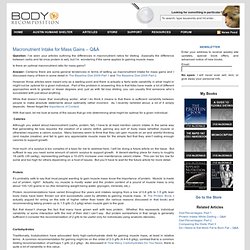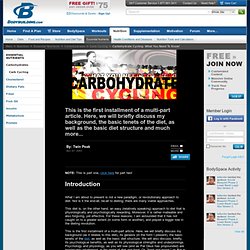

Macronutrient Intake for Mass Gains - Q&A. Question: I’ve seen your articles outlining the differences in macronutrient ratios for dieting (basically the difference between carbs and fat once protein is set), but I’m wondering if the same applies to gaining muscle mass.

Is there an optimal macronutrient ratio for mass gains? Answer: Certainly there are some general tendencies in terms of setting up macronutrient intake for mass gains and I discussed many of them in some detail in The Baseline Diet 2009 Part 1 and The Baseline Diet 2009 Part 2. However, those articles were meant only as a starting point and there is actually a fairly wide variability in what might or might not be optimal for a given individual. Part of the problem in answering this is that folks have made a lot of different approaches work to greater or lesser degrees and, just as with fat loss dieting, you can usually find someone who’s succeeded with just about anything. .Calories Protein But that doesn’t change the fact that many have grown well with less protein.
Carb cycling. The Leangains Guide. It's about time I compiled a comprehensive guide to my system, so here it is.

Intermittent fasting and Leangains How does Leangains differentiate itself from some other intermittent fasting based diets? Here's a brief primer. The basicsIn-depth coverage of my approach, and the benefits of intermittent fasting, can be read about here. A much shorter summary can be found here. Fasting and feeding My general position on the fasted phase is that it should last through the night and during the morning hours. However, the fast could also also be broken later in the day depending on your personal preferences and daily routine. The recommendation for fasting through the earlier part of the day, as opposed to the latter part of the day, is for behavioral and social reasons. The protocols I work with four different protocols depending on when my clients train. Fasted training Training is initiated on an empty stomach and after ingestion of 10 g BCAA or similar amino acid mixture.
Sample setup Key points. Reverse Pyramid Revisited. I've been using a wide variety of training strategies over the years, but the one training style I was most successful with was low volume, high intensity training employed in a reverse pyramid fashion.

A google search on "reverse pyramid training" (RPT) brings you to an article by someone called Randy Herring. You can check out the article here. I was unaware that this training style even had a name for it, as I started to train like this intuitiveley. The greater amount of force you'll be able to generate with your muscles will be when you are freshest in your workout, e.x., the first set of each exercise performed. If a set counts, it is the first one, which is most important. From the article. Besides the basic gist of the system, there isn't much I agree with Randy on; some of the guidelines given in the chart in that article are flat out ridiculous. Either way, let me take you through a back workout and show you how I might use RPT in practise. Deadlift, 2 x 3-5 600 x 3 (max effort) Carbohydrate Cycling: What You Need To Know! What I am about to present is not a new paradigm, or revolutionary approach to diet.

Nor is it the end-all, be-all to dieting; there are many viable approaches. This diet is, on the other hand, an easy (relatively speaking) approach to diet that is physiologically and psychologically rewarding. Moreover, it is rather malleable and also forgiving, yet effective. For these reasons, I am astounded that it has not caught on to a greater extent (in some form or another), and played a bigger role in the dieting revolution. This is the first installment of a multi-part article. However, this installment will address theory and science only minimally, out of necessity. Also in future installments we will discuss synergistic supplementation, variations based on one's phenotype, tweaks for continued fat loss (should they prove necessary), variations for bulking or a steady recomposition, and other variations for those losing too quickly (we should all have that problem shouldn't we?)
How? Veggies.